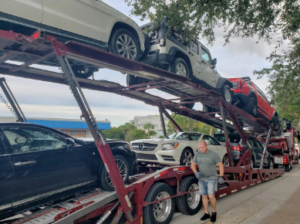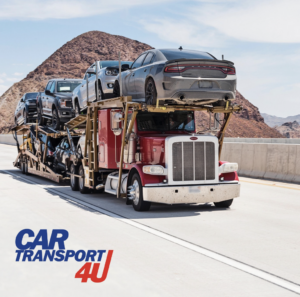How Auto Transporters Decide Where to Place Each Vehicle in the Hauler
When you need to move your car from one place to another, you can rely on the services of auto transporters who will load it onto their truck, or car hauler. But how do they decide where to put each vehicle on the hauler? To understand this process better, let’s explore the various factors that auto transporters consider when placing vehicles on their truck. In this blog post, we’ll discuss how auto transporters decide where to put each vehicle in the hauler.
When transporting vehicles, an auto transporter must consider a few key factors when deciding where to place each vehicle on the hauler. One of the most important considerations is the weight of the vehicle. The heavier the vehicle, the more careful operation is needed. To ensure safe operation and balance, a transporter must place heavier vehicles at the bottom of the hauler and lighter vehicles on top. This helps distribute the load evenly across the hauler’s axles and reduces the risk of overloading or tipping over. Additionally, by strategically placing each vehicle in accordance with its weight, the transporter can optimize fuel efficiency and reduce wear on the hauler’s tires. A transporter should also take into consideration other factors such as placement of equipment like ramps, chains and lights; loading time; physical limitations (i.e., access to crane); desired storage location; the number of lanes available for loading/unloading; how many units can fit on each hauler lane (a typical truck has 12-16 lanes). Ultimately it is up to the carrier and their customer to determine what layout best suits their needs, but one thing remains clear: safety always comes first!

The height and length of the vehicle
When it comes to the operation of an auto transporter, the positioning of each vehicle is a crucial part of the process. It requires an experienced driver to determine the best placement for each car on the hauler based on a variety of factors. The main two criteria that a driver has to consider when loading vehicles onto a hauler are the height and length of each car.
The height of a vehicle is important because it needs to fit within the confines of the hauler’s frame. A car or truck that is too tall could cause safety issues while in transit, so the driver has to make sure that each vehicle will fit properly before they load it onto the trailer.
The length of each car is also important since it has to be placed strategically in order to maximize the space available in the hauler. A driver may need to use a technique known as stacking in order to fit more vehicles on the trailer. This involves placing shorter cars behind longer ones, allowing multiple cars to occupy the same space. A successful stacking operation can increase the total number of vehicles that can be safely transported on one trip.
Ultimately, deciding where to put each vehicle on an auto hauler is an important task for a professional driver. Height and length are key factors that determine how each vehicle should be loaded in order to ensure safe operation during transport.
When auto transporters are loading vehicles onto their hauler, one of the main factors they consider is the value of each vehicle. This is because different cars have different shapes, sizes and weights, meaning some may be more difficult to fit securely in the trailer than others.
For example, a classic or luxury car may require extra care when being loaded and unloaded due to its higher value. Auto transporters will be sure to load these vehicles carefully and make sure they are securely fastened in the truck. On the other hand, a regular car will not require the same level of care as a classic or luxury car and can be loaded quickly and efficiently.
The value of each vehicle also affects the placement on the hauler. For example, if a classic car is being transported, it is important that it be placed securely in the center of the truck so it can be safely held in place during transport. On the other hand, a regular car can be placed anywhere in the truck, including on the sides or in the back.
Finally, auto transporters must take into account any special requests from customers regarding the placement of their vehicles. If a customer wants their vehicle to be placed in a certain area of the truck, then the auto transporter will do their best to accommodate this request.
In conclusion, when auto transporters decide where to put each vehicle on the hauler, they must take into account the value of each vehicle as well as any special requests from customers. By doing so, they can ensure that each vehicle is transported safely and securely.
When auto transporters are faced with the task of transporting vehicles from one place to another, they must first decide where to put each vehicle in the hauler. This can be a complicated process, as it involves consideration of several factors that must be weighed carefully.
First and foremost, the type of vehicle being transported must be taken into account. Different types of vehicles can require different amounts of space in order to fit properly and securely. Automobiles, for example, generally take up less room than larger vehicles such as trucks and SUVs. It’s important that the auto transporter understands the size and shape of each vehicle they are transporting and plans accordingly.
In addition, the size and weight of the vehicle must also be considered. For example, a large truck may require more space on the hauler due to its weight, which means that other vehicles may need to be placed farther away in order to ensure balance. Similarly, if two cars of similar size are being transported, but one is much heavier than the other, this will also need to be taken into account.
Finally, the auto transporter must consider how the vehicles will interact with one another during transport. For instance, a large SUV may need to be placed at the rear of the hauler to provide support for smaller vehicles that are positioned in front. Alternatively, two cars of similar size may be placed side by side or stacked one on top of the other in order to save space.
By taking all of these factors into consideration, auto transporters can ensure that each vehicle is securely and safely transported. This means that when you choose an auto transporter, you can be confident that your vehicles will arrive at their destination safely and securely!
transporting multiple vehicles at the same time, auto transporters have to be strategic about how they load each vehicle onto the hauler. Knowing where to place each car, truck, or SUV on the hauler can help ensure that all of the vehicles arrive safely at their destination.
Auto transporters use a number of different factors to determine the best way to load each vehicle onto the hauler. The size and weight of the vehicle, as well as its clearance requirements, all play a role in deciding how to fit the vehicles in the hauler.
The goal is to maximize the use of space while also ensuring that all vehicles fit securely in the hauler. Auto transporters begin by loading the largest and heaviest vehicles first, since they require more space and require more secure strapping. Smaller and lighter vehicles are then loaded on top of the heavier ones.
When it comes to clearance, auto transporters must ensure that there is adequate space between each vehicle. If a vehicle requires more space due to its height or width, then it should be loaded with extra clearance between it and other vehicles. This helps prevent any accidental contact between them during transport.
When loading a hauler with multiple vehicles, auto transporters must also consider any hazards that may be present on the road. Heavy braking and sudden turns can cause vehicles to shift on the hauler, so auto transporters must take extra precautions when securing them in place. They use wheel chocks and straps to ensure that no vehicle will move or become loose during transit.
Ultimately, auto transporters must use their experience and knowledge to decide where to put each vehicle on the hauler in order to ensure its safety and secure delivery.
For auto transporters, the task of loading and unloading cars onto the hauler can be a tricky one. It requires careful planning and precision to ensure that each vehicle is safely secured for transport. So, how exactly do auto transporters decide where to place each vehicle on the hauler?
Auto transporters typically have a set loading plan that they follow when loading vehicles onto the hauler. It’s important that they take into account the size and weight of each vehicle, as well as its intended destination, in order to ensure that it is properly secured for transport.
When unloading the truck, the auto transporter will first assess the situation and determine the safest way to unload the vehicles. They’ll usually start by unloading heavier or larger vehicles first and then work their way down to smaller or lighter ones. This helps to prevent any potential tipping or shifting of the hauler during transit.
Once all the vehicles have been unloaded, the auto transporter will then inspect each one to make sure that they are in good condition before they are allowed to drive away. In some cases, if any damage is discovered, they may need to be repaired before they can be safely driven away.
By taking into consideration the size and weight of each vehicle, along with its destination, auto transporters are able to safely and securely load and unload cars onto the hauler. This ensures that each vehicle is transported safely and securely, reducing the risk of any damages occurring during transit.

Route
4U - Car Shipping & Logistics
Email: info@cartransport4u.com
URL: https://cartransport4u.com/
| Monday | 09:00 - 17:00 |
| Tuesday | 09:00 - 17:00 |
| Wednesday | 09:00 - 17:00 |
| Thursday | 09:00 - 17:00 |
| Friday | 09:00 - 17:00 |
| Saturday | 09:00 - 17:00 |
| Sunday | 09:00 - 17:00 |
East Coast USA
(857) 406-8183
54 Farm Rd
Marlboro, MA
01752
